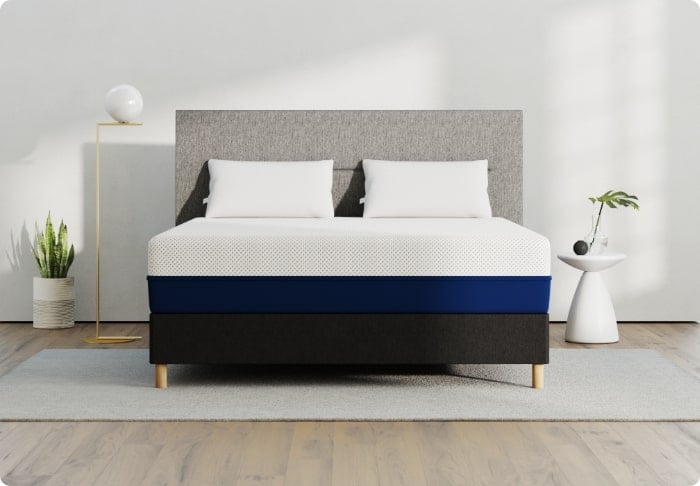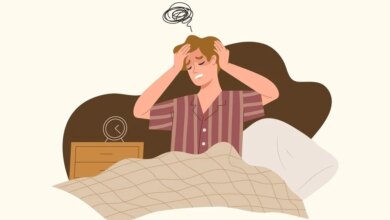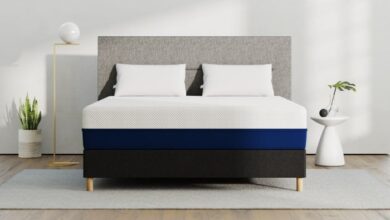Bedside Caddy, the Simple Tool for Organizing Around the Bed

Quick answer: A bedside caddy is a hanging organizer that attaches to your bed to store phones, glasses, books, and other essentials. It saves floor space, eliminates the need for nightstands, and is perfect for dorms, small apartments, and bunk beds. Most attach by tucking between your mattress and frame or using adjustable straps. Key features: multiple pockets, cable holes, and 5-20 pound weight capacity.
Key Takeaways
- What it is: A hanging storage organizer with multiple pockets that attaches to your bed for easy access to nighttime essentials (phone, glasses, books, water bottle)
- Main benefits: Saves floor space, eliminates need for nightstands, keeps items within arm’s reach, reduces sleep disruptions, and creates a clutter-free bedroom
- Best for: Dorm rooms, small apartments, bunk beds, shared beds, or anyone wanting better bedside organization
- Attachment methods: Slides between mattress and frame, adjustable straps for bed rails, or clips to headboards—works with most bed types including platform and adjustable beds
- Materials: Felt (device protection), Oxford fabric (waterproof/easy cleaning), canvas (heavy-duty), or metal-framed (maximum stability)
- Essential features: Multiple pocket sizes, charging cable holes, mesh compartments for bottles, and appropriate weight capacity (5-20 pounds depending on design)
- Organization tips: Place frequently used items at eye level, distribute weight evenly, keep cables tidy, clean monthly, and avoid overloading
- DIY option: Can create custom caddies using fabric and fusible fleece with sewing or fabric glue for no-sew versions
Your bedroom should feel like a peaceful retreat, but cluttered nightstands and items scattered around your bed can make it feel chaotic instead. Many people struggle to keep their phone, glasses, books, and other essentials organized and within easy reach while they sleep or relax.
A bedside caddy offers a simple solution that transforms how you organize your bedroom space. These handy storage tools hang right beside your bed and keep everything you need close at hand without taking up valuable floor space.
Whether you live in a tiny dorm room, sleep on a bunk bed, or simply want better organization, bedside caddies work for almost any sleeping arrangement. They attach securely to your bed and provide multiple pockets for all your nighttime necessities.
Read on to discover how choosing the right bedside caddy can improve your sleep routine and help you create the organized, relaxing bedroom you deserve.
What Makes a Bedside Caddy So Useful
Smart bedroom organization starts with keeping your most-used items within easy reach of your bed. And a bedside caddy works as a hanging storage organizer that keeps your most important items right where you need them. You can store your phone, glasses, books, remote control, and water bottle in separate pockets that hang directly beside your bed.
The caddy attaches securely to your mattress or bed frame without taking up any floor space or requiring a nightstand. Most caddies feature multiple compartments of different sizes to hold everything from small items like earbuds to larger objects like tablets or paperback books.
This design lets you grab what you need without getting out of bed or fumbling around in the dark. The primary purpose centers on creating easy access to your essentials while keeping your sleeping area neat and tidy.
Why bedside organization matters for better sleep and convenience
Good bedside organization directly impacts how well you sleep and how smoothly your daily routines flow. When you keep your phone, water, and other necessities within arm’s reach, you avoid the stress of searching for items in the middle of the night.
This reduces sleep disruptions and helps you fall back asleep faster after checking the time or taking a sip of water. An organized bedside area also creates a calming environment that signals to your brain it’s time to relax and unwind.
You spend less time cleaning up scattered items and more time enjoying your bedroom as a peaceful retreat. Plus, having everything in its proper place makes your morning and bedtime routines much more efficient and stress-free.
Who benefits most from using these storage solutions
College students living in cramped dorm rooms find bedside caddies especially valuable because they maximize storage without requiring extra furniture, swiftly and efficiently improving a dorm bed on a budget. People who sleep on bunk beds can’t easily reach a traditional nightstand, so hanging storage becomes their best option for keeping essentials nearby.
Anyone living in small apartments or tiny homes uses these caddies to make the most of their limited space. Parents with young children often choose bedside caddies to keep important items safely stored but easily accessible during nighttime care.
People who read books in bed, work on laptops, or charge multiple devices also benefit from the organized storage and built-in cable management features. Even those with traditional nightstands discover that bedside caddies provide extra storage and help reduce nightstand clutter.
The Practical Benefits of Bedside Caddies
Bedside caddies solve real problems that many people face in their sleeping spaces. These practical storage solutions work especially well in situations where traditional nightstands just won’t fit or function properly.
Perfect solution for spaces without nightstands
Many bedrooms simply don’t have room for a traditional nightstand, but bedside caddies fill this storage gap perfectly. You can hang a caddy beside any bed without worrying about floor space, furniture placement, or room layout constraints.
The vertical hanging design takes advantage of unused space between your mattress and the wall or bed frame. This approach works especially well in narrow bedrooms where a nightstand would block walkways or make the room feel cramped.
You still get all the storage benefits of a nightstand without sacrificing precious square footage. Plus, you can easily move or remove the caddy whenever you need to rearrange your space or clean around your bed.
Ideal for dorm rooms and small living spaces
College dorm rooms and studio apartment bedrooms present unique storage challenges that bedside caddies handle beautifully. These small spaces often force you to choose between having storage or having enough room to move around comfortably.
A bedside caddy gives you both by hanging vertically and keeping your essentials organized without eating up floor space. Many dorm rooms come with extra-long twin beds that sit higher off the ground, making bedside caddies even more practical for easy access.
You can pack more into your limited space while keeping everything you need for studying, sleeping, and relaxing within reach. The portable nature of these caddies also makes them perfect for students who move frequently between dorms or apartments.
Essential for bunk bed users
Bunk bed users face a unique challenge since traditional nightstands don’t work with elevated sleeping surfaces. The top bunk sits too high for most nightstands, while the bottom bunk often has limited space due to the overhead structure.
Bedside caddies solve both problems by attaching directly to the bed frame or mattress at the perfect height for each sleeper. Kids and adults on bunk beds can safely store their water bottles, books, phones, and other items without worrying about things falling to the floor.
This setup reduces the risk of accidents from climbing down to reach items during the night. The secure attachment also prevents items from shifting around when someone moves on the opposite bunk.
Keeping nighttime essentials within arm’s reach
Easy access to your nighttime necessities can make the difference between a good night’s sleep and a restless one. Bedside caddies position your phone, glasses, medications, and water exactly where you can grab them without fully waking up or getting out of bed.
This convenience becomes especially important when you need to check the time, take medication, or stay hydrated during the night. The organized pockets help you find what you need quickly, even in complete darkness, since each item has its designated spot.
You avoid the frustration of knocking things over or searching blindly on a crowded nightstand surface. This smooth access to essentials helps you maintain better sleep patterns and wake up feeling more rested.
How Bedside Caddies Attach and Stay Secure
Understanding the different attachment methods helps you choose a bedside caddy that will work perfectly with your specific bed setup. Each attachment style offers unique advantages depending on your bed type and personal preferences.
The mattress-and-frame insertion method
The most common attachment method involves sliding a long fabric flap between your mattress and bed frame or box spring. You simply lift your mattress slightly and tuck the flap underneath, then let the mattress weight hold the caddy securely in place.
This method works with most standard bed frames and requires no additional hardware or complicated installation steps. The friction between the mattress and frame keeps the caddy from sliding around, even when you’re getting in and out of bed frequently.
Most caddies using this method include a wide flap that distributes weight evenly and prevents the caddy from sagging or pulling loose. You can easily remove and reposition the caddy whenever you need to change your bedding or rearrange your room.
Adjustable strap systems for bed rails
Many bedside caddies feature adjustable straps with hook-and-loop fasteners that wrap securely around bed rails or frame components. These straps work especially well with metal bed frames, bunk beds, and platform beds that have accessible rails or posts.
You can adjust the strap length to fit different frame thicknesses and create a custom fit that keeps the caddy exactly where you want it. The hook-and-loop design allows for quick adjustments and easy removal when needed for cleaning or storage.
This attachment method provides excellent stability and prevents the caddy from shifting during use. The adjustable nature means one caddy can work with multiple bed types if you move or change furniture.
Headboard attachment options
Some bedside caddies attach directly to headboards using clips, straps, or specialized mounting hardware designed for this purpose. This method works particularly well with slatted headboards, upholstered headboards with accessible frames, or headboards with built-in storage compartments.
Headboard attachment keeps the caddy positioned higher up, making it easier to reach items while sitting up in bed reading or using electronic devices. The stable connection to the headboard prevents swaying and provides a secure anchor point that doesn’t depend on mattress weight or frame design.
You’ll want to check that your headboard can support the weight of the loaded caddy and won’t be damaged by the attachment mechanism. This option often provides the most organized appearance since the caddy integrates seamlessly with your bed’s existing structure.
Choosing the right attachment style for your bed
Your bed type, room layout, and personal preferences all influence which attachment method will work best for your situation. Platform beds and beds without box springs work perfectly with mattress-insertion caddies, while metal frames and bunk beds often require strap-based attachment systems.
Consider how often you’ll need to remove the caddy for cleaning or moving, as some attachment methods offer quicker setup and removal than others. Think about the weight of items you plan to store, since heavier loads require more secure attachment methods like reinforced straps or headboard mounting.
Test the attachment method with your specific bed setup to ensure the caddy hangs at the right height and angle for comfortable access. The right attachment choice will keep your caddy secure and functional for years of daily use.
Essential Features to Look For
Knowing which features matter most helps you choose a bedside caddy that truly meets your daily needs. The right combination of features can make the difference between a caddy you love and one that sits unused.
- Multiple pocket sizes and configurations – Well-designed caddies include various pocket sizes from small slots for phones to large pouches for books, with the best layouts placing frequently used items in the most accessible spots.
- Charging cable access holes – Built-in cable management features keep charging cords organized through small holes or grommets, letting you charge devices overnight while keeping them safely stored and preventing tangled messes.
- Mesh compartments for bottles and larger items – Mesh pockets provide excellent visibility and ventilation for water bottles or electronics while stretching to accommodate different sizes and preventing moisture buildup.
- Weight capacity considerations – Understanding how much weight your caddy can safely hold prevents damage, with most fabric versions handling 5-10 pounds and metal-framed options supporting 15-20 pounds or more.
These essential features work together to create a bedside caddy that fits seamlessly into your nightly routine. Focus on the features that match your specific storage needs rather than choosing based on the most options available.
Popular Bedside Caddy Styles and Examples
Different bedside caddy styles cater to specific needs and preferences, making it easier to find one that fits your lifestyle perfectly. Understanding these popular designs helps you identify which style will work best in your bedroom setup.
Simple felt organizers with multiple pockets
Basic felt caddies offer straightforward storage with several pockets of different sizes arranged in a simple, functional layout. These designs typically feature three to five compartments that hang in a vertical arrangement, with the largest pocket at the bottom for books or tablets.
The soft felt material protects your devices while providing enough structure to keep the pockets properly shaped and easily accessible. Many people prefer these simple designs because they’re affordable, lightweight, and blend well with most bedroom décor styles.
The clean lines and neutral colors of felt caddies work especially well in minimalist or modern bedrooms where you want storage that doesn’t draw attention. These basic models usually attach using the mattress-insertion method, making them compatible with most standard bed frames without requiring any special hardware.
Waterproof Oxford fabric models with seven compartments
Advanced Oxford fabric caddies pack maximum storage into a compact design, often featuring seven or more specialized compartments for different types of items. These models typically include dedicated spaces for phones, tablets, glasses, remotes, water bottles, books, and small accessories like earbuds or charging cables.
The waterproof material protects your belongings from spills and makes cleaning simple when accidents happen. Many seven-compartment designs arrange pockets in both vertical and horizontal orientations to maximize storage while keeping everything within easy reach.
The sturdy Oxford fabric maintains its shape even when fully loaded, ensuring that all compartments remain functional and accessible over time. These comprehensive storage solutions work particularly well for people who keep many different items bedside or share a bed with someone who has different storage needs.
Hook-and-loop strap designs for bunk beds
Specialized bunk bed caddies use adjustable hook-and-loop straps that wrap securely around bed rails, posts, or ladder components. These designs solve the unique storage challenges that bunk bed users face by attaching at the perfect height for each sleeping level.
The adjustable straps accommodate different rail thicknesses and shapes, making them compatible with both metal and wooden bunk bed frames. Many bunk bed caddies feature reinforced attachment points and extra-secure fastening systems to handle the movement that occurs when people climb up and down.
The compact size of these caddies ensures they don’t interfere with ladder access or create safety hazards in the tight spaces around bunk beds. Some models include safety features like rounded corners and secure closures to prevent items from falling onto the person sleeping below.
Multi-compartment caddies for books and electronics
Heavy-duty caddies designed for books and electronics feature reinforced construction and strategic weight distribution to handle substantial loads safely. These models often include padded compartments specifically sized for tablets, e-readers, laptops, and thick textbooks or reference materials.
The multiple compartments help organize different types of items while preventing heavier objects from crushing or damaging lighter electronics stored in the same caddy. Many book-focused designs feature wider, deeper pockets that can accommodate multiple paperbacks or a few hardcover volumes without stretching the fabric.
Electronics-oriented caddies often include built-in cable management, device-specific slots, and protective padding to keep expensive gadgets safe from scratches and impacts. These specialized storage solutions work especially well for students and professionals working on laptops in bed, or avid readers who need organized access to multiple books and devices from their bedside.
Creating Your Own DIY Bedside Caddy
Making your own bedside caddy lets you customize the size, pockets, and style to match your exact storage needs. DIY projects also cost less than buying ready-made caddies and give you the satisfaction of creating something useful with your own hands.
Planning your custom storage needs
Start by measuring the items you want to store and sketching out your ideal pocket arrangement on paper before cutting any fabric. Consider the height and width of your phone, tablet, books, water bottle, and other essentials to determine the best pocket dimensions.
Think about which items you reach for most often and plan to place those pockets in the most accessible locations. Measure the space beside your bed to ensure your finished caddy won’t hang too low or extend too far from the mattress edge.
Make a list of all the materials you’ll need, including fabric, thread, measuring tools, and any special features like cable holes or reinforcement strips. Planning thoroughly before you start sewing saves time and prevents costly mistakes that could ruin your project.
Sewing projects using fabric and fusible fleece
Choose sturdy fabric like canvas or heavy cotton for the main body, then add fusible fleece backing to create structure and prevent sagging when loaded. Cut your fabric pieces according to your planned dimensions, leaving extra material for seam allowances and the attachment flap that slides under your mattress.
Iron the fusible fleece onto the wrong side of your main fabric piece, following the manufacturer’s instructions for temperature and timing. Create individual pockets by sewing smaller fabric rectangles onto the main panel, leaving the tops open for easy access to stored items.
Add bias tape or sturdy fabric strips along the edges to prevent fraying and give your caddy a professional finished appearance. Test your attachment method and pocket accessibility before doing final stitching to ensure everything works as planned.
No-sew alternatives with fabric glue
Fabric glue offers a quick alternative for people who don’t own a sewing machine or prefer not to hand-stitch their caddy. Choose a thick, sturdy fabric that won’t fray easily, such as felt or canvas, since you won’t have sewn edges to prevent unraveling.
Cut your main panel and pocket pieces, then use high-quality fabric glue to attach pockets in your planned arrangement. Apply glue along three edges of each pocket, leaving the top open, and press firmly for the recommended bonding time.
Add reinforcement by gluing fabric strips or bias tape along stress points where pockets might pull away from the main panel under weight. Allow the completed caddy to cure for the full recommended time before testing it with your actual storage items.
Customizing pocket sizes for specific items
Measure your specific devices and personal items to create pockets that fit perfectly rather than using generic dimensions. Make your phone pocket slightly wider and taller than your device to allow for protective cases and easy insertion and removal.
Create tablet pockets with enough depth to prevent your device from sliding out but shallow enough that you can grasp it easily. Design book pockets based on your most commonly read sizes, whether that’s paperback novels, textbooks, or magazines.
Add small loops or elastic strips inside pockets to hold items like pens, charging cables, or earbuds securely in place. Consider creating expandable pockets with pleats or gussets for items that vary in size, like water bottles or personal care products that you might swap out seasonally.
FAQs
How much weight can a bedside caddy safely hold?
Most fabric bedside caddies hold 5-10 pounds safely, while metal-framed versions can support 15-20 pounds or more depending on their construction quality.
Will a bedside caddy work with my adjustable bed frame?
Yes, bedside caddies work perfectly with adjustable beds using the mattress-insertion method that moves naturally as you change bed positions.
Can I wash my bedside caddy in the washing machine?
Many bedside caddies are machine washable, but you should always check the care label and use cold water with air drying to prevent damage.
Do bedside caddies work with platform beds that don’t have box springs?
Bedside caddies work excellently with platform beds since they rely on mattress weight rather than box springs for secure attachment.
How do I prevent my bedside caddy from sliding or moving around?
Insert the attachment flap as far as possible between your mattress and frame while distributing weight evenly across all pockets to maintain stability.
Can I use a bedside caddy if I share my bed with a partner?
Bedside caddies work perfectly for couples since each person can have their own caddy for personalized storage on their side of the bed.
Are bedside caddies safe to use around young children?
Bedside caddies are generally safe around children when you choose secure designs and store dangerous items in higher, less accessible pockets.
Conclusion
A bedside caddy transforms your sleeping area from cluttered and stressful into organized and peaceful with minimal effort and cost. These simple storage solutions work in any bedroom setup, whether you have a spacious master suite or a tiny dorm room.
The key lies in choosing the right material, attachment method, and pocket configuration that matches your specific needs and lifestyle. Once you experience the convenience of having your phone, glasses, books, and other essentials exactly where you need them, you’ll wonder how you ever managed without this simple organization tool.
Regular maintenance and smart loading practices ensure your caddy continues working effectively for years of reliable service. The improved sleep quality and smoother daily routines that come from proper bedside organization make investing in a quality caddy one of the smartest bedroom upgrades you can make.
Take time to evaluate your current bedside situation and choose a caddy that will truly enhance your rest and relaxation space.



